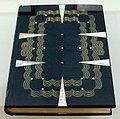Pierre Legrain
Pierre-Émile Legrain (born October 2, 1889 in Levallois-Perret , † July 17, 1929 in Paris ) was a French bookbinder , furniture designer and interior designer of Art Deco .
Life
As the son of a wealthy industrialist, Pierre Legrain enjoyed a happy childhood. He was a student at the Catholic institution Notre-Dame de Sainte-Croix in Neuilly-sur-Seine . At the age of 12 he asked his parents to let him go and instead allow him to take drawing lessons, whereupon he attended the École des Arts Appliqués Germain Pilon . In 1908 he entered the studio of the designer Paul Iribe (1883-1935), with whom he worked in 1912 on the interior of the apartment of the fashion designer and patron of the arts Jacques Doucet . Although he was declared unfit for service due to a heart defect in World War I , Legrain insisted on being drafted. His secretarial service enabled him to make drawings for publications such as Assiette au beurre , Le Journal , Le Témoin and Le Mot .
In 1916, Doucet hired the artist to design covers for Doucet's collection of books and manuscripts. Legrain, who at this time had no experience as a bookbinder, set up shop in Doucets dining room and designed around 370 covers between 1917 and 1919, most of them by the bookbinder René Kieffer , but also by his colleagues Georges Canape , Henri Noulhac and Germaine Schroeder were executed. Legrain then designed furniture and other art objects for Doucet. At this time, Legrain also received an order from Jeanne Tacharp to renovate her house in Paris and her villa in La Celle-Saint-Cloud . Its design extended from the door locks and the lighting to the furniture and the silverware and into the garden.
In 1919 Legrain exhibited his bindings at the Salon of the Société des Artistes Décorateurs . After receiving the Prix Blumenthal , newspaper articles reporting on his bindings attracted a great deal of attention from 1922 onwards. As a result, the demand for his work rose sharply, so that Legrain was able to choose its customers and the objects to be bound. In November 1923 he gave a special exhibition in the Briant-Robert gallery. Together with Pierre Chareau , Jacques-Émile Ruhlmann , Robert Mallet-Stevens and Paul Poiret , Legrain showed in 1924 at the Salon of the Société des artistes décorateurs a furniture collection entitled La réception et l'intimité d'un appartement modern (The reception and the intimacy a modern apartment). The avid luxury lover Pierre Meyer commissioned Legrain to renovate his mansion on Parisian Avenue Montaigne. There Legrain was able to let his creative imagination run free with unlimited resources.
He set up his own workshop, where he now handcrafted his designs himself. Although there was a great demand for other decoration work, he preferred the production of bindings. In doing so, his designs moved away from the initially simple linear geometric patterns to more complicated and often asymmetrical compositions, which he conceived with architectural rigor regardless of their apparent lightness. In addition to leather, he used a wide range of materials for the design. His work as exhibited at the Exposition Internationale des Arts Décoratifs et industriels modern in Paris in 1925 cemented his reputation as a leading designer of French bindings. His best designs come from his “creative frenzy” between 1925 and his death in 1929. Pierre Legrain died after a heart attack.
Works (selection)
Book cover, 1928, Museu Calouste Gulbenkian
Portfolio with metal lid, circa 1925, Metropolitan Museum of Art
literature
- Victoria Charles: 1000 Masterpieces of Decorative Art. Parkstone International, New York City 2014, ISBN 978-1-7831-0460-4 , p. 415.
- Alastair Duncan : Encyclopedia of Art Deco. William Collins, Sydney 1988, ISBN 0-7322-0013-X , pp. 42, 51, 54, 58, 71, 88-90.
- Jared Goss : French Art Deco. Metropolitan Museum of Art, New York City 2014, ISBN 0-300-20430-2 , pp. 131, 133, 135, 241, 258.
- Eric Knowles : Art Deco. Shire Collections, Bloomsbury Publishing, New York City 2014. ISBN 0-7478-1521-6 , pp. 31, 57.
- Yves Peyré, H. Georges Fletcher: Art Deco Bookbindings. The Work of Pierre Legrain and Rose Adler. Princeton Architectural Press, New York 2004, ISBN 1-56898-462-6 .
- Laurence Salmon: Pierre Legrain. Norma, Barcelona 2020, ISBN 978-2-3766-6017-0 , 304 pp.
Web links
- Pierre Legrain (French, 1888-1929). In: artnet , with pictures of Legrain's work.
- Pierre Legrain. In: docantic.com
- Pierre-Émile Legrain. In: Smithsonian National Museum of African Art
- Pierre Legrain: An Inventory of His Binding Design Albums in the Art Collection at the Harry Ransom Center. In: Harry Ransom Center, University of Texas at Austin
| personal data | |
|---|---|
| SURNAME | Legrain, Pierre |
| ALTERNATIVE NAMES | Legrain, Pierre-Émile (maiden name) |
| BRIEF DESCRIPTION | French bookbinder, furniture designer and interior designer |
| DATE OF BIRTH | October 2, 1889 |
| PLACE OF BIRTH | Levallois-Perret , France |
| DATE OF DEATH | July 17, 1929 |
| Place of death | Paris |





